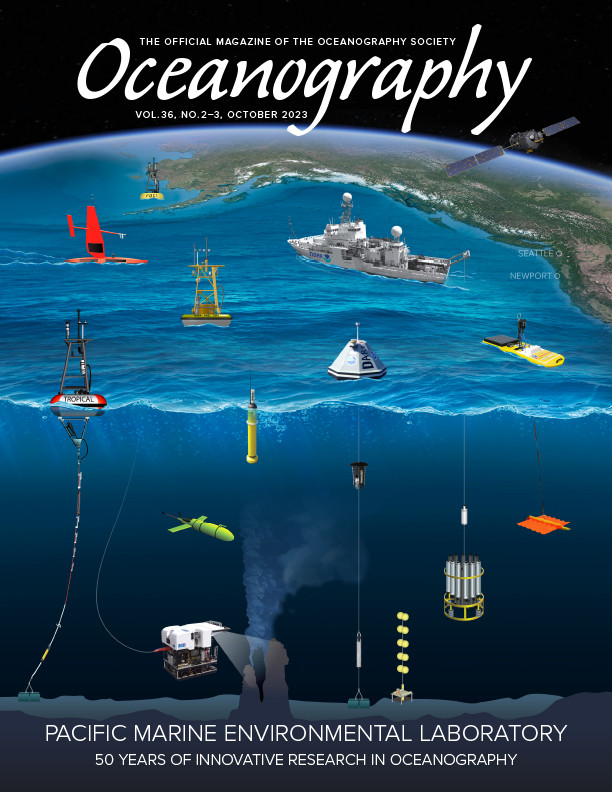Full Text
|
|
As with other elements of the Global Ocean Observing System (GOOS), building and sustaining the Global Tropical Moored Buoy Array (GTMBA) has had its own set of challenges. Moored buoys are fish aggregation devices, so they attract fishermen who often either intentionally or inadvertently damage the moorings. Fishing vandalism is the greatest source of data and equipment loss in the array, and it has no easy solution. Deploying and recovering deep ocean moorings requires specially equipped research vessels with the necessary size, endurance, and speed to carry out operations safely and efficiently. Such ships are in high demand and in short supply. Likewise, maintaining adequate funding levels to support a network of 100 or more moorings in the global tropics has always been difficult. The funding and ship time challenges have been mitigated in part by the formation of multi-national partnerships that underpin the success of the overall venture. Two challenges unique to the past decade, however, have been piracy and the coronavirus (COVID-19) pandemic.
Piracy became a decade-long scourge off equatorial east Africa beginning around 2005. Somali pirates would frequently assault, board, and hijack ships transiting the region, sometimes kidnapping crew members and holding them hostage for ransom. In response, the shipping industry established a piracy high-risk area that included the entire Arabian Sea north of 10°S (Figure 1). As a result, the Arabian Sea became essentially off-limits for scientific cruises, thus limiting development of the Research Moored Array for African-Asian-Australian Monsoon Analysis and Prediction (RAMA). Eventually, naval vessels from nations patrolling the region began to systematically intercept pirate ships, capturing, prosecuting, and incarcerating pirates. These concerted actions led to the suppression of piracy and successive reductions in the high-risk area (Figure 1), so that eventually NOAA Ship Ronald H. Brown was able to deploy RAMA moorings in the northern Arabian Sea for the first time on its around-the-world voyage in 2018.
|
|
Coincidentally, as piracy waned in the Arabian Sea a decade after it began, it increased in the Gulf of Guinea, initially concentrated near the coast and around ports. Beginning in 2014, the French government restricted its research vessels from operating in high-risk areas of the Gulf and later forbade ships from entering ports in West Africa affected by piracy. The high-risk area in the Gulf of Guinea was expanded in 2020 in response to additional pirate attacks (Figure 1). These constraints complicated the logistics and increased costs for servicing Prediction and Research Moored Array in the Tropical Atlantic (PIRATA) buoys in the eastern part of the array, requiring a shift of the PIRATA mooring at 0°, 0° to 0°, 3°W in 2021.
The COVID-19 pandemic had serious ramifications for GTMBA maintenance (Boyer et al., 2023). In particular, cruise cancellations and international travel restrictions made it impossible to service RAMA moorings on a regular basis. Prior to the pandemic, five to eight cruises per year were conducted to maintain RAMA, but between December 2019 and early 2023, only a single cruise by the Korean Research Vessel Isabu was carried out, in January 2022, to service three moorings along 67°E. As a result, all RAMA moorings were deployed well beyond their one-year design lifetimes, and almost all of them had stopped transmitting by early 2023 due to power loss, mechanical failure, or vandalism. As one measure of impact, real-time data return in RAMA decreased dramatically from pre-COVID levels of 87% in December 2019 to 2% near the end of the pandemic in December 2022 (Table 1).
TABLE 1. Real-time data return for TAO, PIRATA, and RAMA just prior to the start of the COVID-19 pandemic (December 2019) and toward its end (December 2022). > High res table |
The Tropical Atmosphere Ocean (TAO) array and PIRATA fared much better than RAMA during COVID-19. It was possible to maintain a regular TAO servicing schedule using US charter vessels so real-time data return was within the range of normal year-to-year variations (Table 1). Three PIRATA cruises were canceled due to the pandemic, resulting in a drop in real-time data return from 62% in December 2019 to just over 50% in late 2021. All planned PIRATA cruises were conducted in 2022, however, so that real-time data return rebounded to 88% by the end of the year (Table 1). Note that PIRATA data return in 2019 was exceptionally low by historical standards primarily because the Brazilian ship that was planned for the PIRATA cruise that year was diverted to investigate a large oil spill off the coast of Northeast Brazil. Thus, the large overall increase for PIRATA data return in Table 1 is conditioned in part by the relatively low starting point in this comparison.
COVID-19 affected not only cruise schedules and data return. For GTMBA cruises that were successfully conducted during the pandemic, quarantine requirements and quadrupled shipping costs due to supply chain issues added complexity and expense to cruise logistics. Fieldwork is returning to normal as we emerge from COVID-19, and efforts to assess the impact of mooring data losses on forecasts and analyses, particularly in the Indian Ocean, are now underway.
Acknowledgment
PMEL contribution no. 5496.




